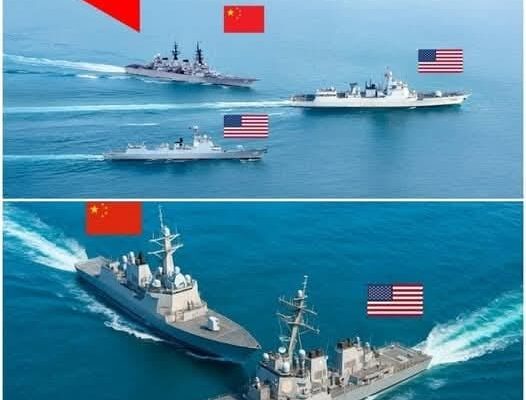The Encounter
The USS Princeton was on standard freedom-of-navigation duty—a routine mission through international waters claimed by Beijing as its own—when radar operators picked up the Jon Chong roughly 200 kilometers away. The Chinese vessel was moving fast, its course aggressive and direct. Within minutes, the Princeton’s combat information center came alive with activity.
According to naval analysts, the Chinese captain had received explicit instructions from Beijing: intercept the American warship and force it to alter course. The order was a bold move, intended to demonstrate China’s dominance in what it calls its territorial waters. But on that day, the U.S. Navy wasn’t in the mood to be intimidated.
The Princeton’s Readiness
The USS Princeton, a Ticonderoga-class cruiser, is no ordinary ship. Outfitted with the Aegis Combat System and armed with 122 vertical launch cells, it can engage multiple air, sea, and missile threats simultaneously. Its radar array can detect and track hundreds of targets, while its SM-6 surface-to-air missiles give it a deadly reach far beyond the horizon.
When the Jon Chong began closing the gap, the Princeton’s crew shifted into high alert. Tactical teams monitored every movement of the Chinese destroyer. The captain ordered a defensive posture but held fire, following strict engagement rules designed to prevent escalation.
The Chinese vessel, however, was not merely shadowing—it was testing boundaries. As it neared within 80 kilometers, signals intelligence confirmed that its missile systems were active. The Jon Chong carried YJ-18 anti-ship missiles, capable of striking at supersonic speeds with devastating accuracy. For a few tense minutes, it looked like both ships were seconds away from unleashing chaos.
A Deadly Standoff
Military insiders later described the encounter as a “deadly dance.” Both ships circled cautiously, each broadcasting power without crossing the line into outright combat. The U.S. crew, trained for such high-stress situations, relied on calm discipline. The Princeton’s radar locked onto the Chinese destroyer’s coordinates, and a firing solution was quietly computed—ready to launch SM-6 interceptors at the first sign of a missile threat.
The Chinese captain, realizing he was staring down one of the world’s most capable warships, hesitated. For all its bluster, Beijing’s navy knew that one miscalculation could set off an international crisis it wasn’t prepared to handle.
The Balance of Power
Experts have pointed out that this confrontation, while brief, revealed an uncomfortable truth: despite China’s rapid military expansion, the U.S. Navy still holds the technological and strategic edge in open conflict. The Princeton’s radar and missile systems outclassed the Jon Chong in both range and precision.
“The U.S. doesn’t need to start a fight to win one,” said retired Rear Admiral Thomas Pierce. “Just the capability to neutralize incoming missiles before they reach their target sends a message: you don’t mess with an Aegis-equipped cruiser.”
Indeed, the standoff ended without a shot being fired. After nearly an hour of tension, the Jon Chong veered off, maintaining a safe distance as it shadowed the Princeton until dusk. Then, quietly, it turned back toward the Chinese mainland.
A Message Sent
While no official statements were made by either government, analysts agree that the event served as a reminder of just how volatile the South China Sea has become. For years, Beijing has been building artificial islands, installing missile batteries, and declaring control over vast stretches of ocean that international law recognizes as international waters.
The U.S., meanwhile, continues to challenge those claims through freedom-of-navigation operations, ensuring that sea lanes remain open to global trade. Encounters like the one between the Princeton and the Jon Chong are becoming increasingly frequent—and increasingly dangerous.
“This was a test,” said Asia-Pacific security expert Mei Lin Huang. “China wanted to see how far it could push the U.S. without crossing the line. What they got was a demonstration that American resolve—and capability—remains unmatched.”
The Broader Implications
The confrontation comes at a time when regional tensions are already high. Just weeks earlier, Chinese aircraft had buzzed U.S. surveillance planes near Taiwan, and Chinese coast guard vessels had harassed Philippine resupply missions in the Spratly Islands. Each incident adds fuel to an already combustible situation.
The South China Sea is more than a geopolitical chessboard—it’s a vital artery for global commerce. Roughly one-third of the world’s shipping passes through these waters, carrying trillions of dollars in goods. Whoever controls it wields enormous influence over the global economy.
For Washington, maintaining an open and stable South China Sea isn’t just about strategy—it’s about safeguarding global order. For Beijing, asserting dominance there is central to its long-term ambition of regional supremacy. And when those two visions collide, even a “routine” patrol can turn into a potential flashpoint.
Lessons Learned
After the incident, Pentagon officials quietly reaffirmed their stance: U.S. naval operations in international waters will continue, and any attempt to intimidate or restrict them will be met with calm but firm resistance. Behind the scenes, the encounter was dissected as both a warning and a reaffirmation of U.S. deterrence power.
“China is learning the hard way,” one senior defense analyst noted, “that posturing is not the same as power. The U.S. Navy doesn’t bluff—it prepares.”
Meanwhile, in Beijing, the failed provocation sparked internal debate. Reports suggest that military planners have begun reassessing the risks of direct confrontation, especially with ships like the Princeton that can counter China’s missile systems before they even launch.
The Takeaway
No missiles were fired. No lives were lost. But the message was clear: the South China Sea remains a powder keg, and the U.S. Navy is still the dominant force on those waters.
For all of Beijing’s growing confidence, the events of June 14 proved that challenging American naval power carries consequences—sometimes without a single shot being fired.
In the end, the Jon Chong’s retreat was not just a tactical decision; it was a symbolic one. The confrontation underscored that while China may claim the South China Sea, the United States still commands it.
And as both nations continue to patrol those waters, one truth remains unshaken—the next “routine” encounter could define the balance of power for decades to come.










